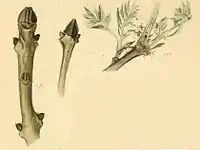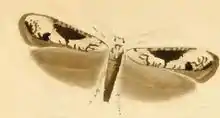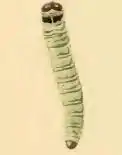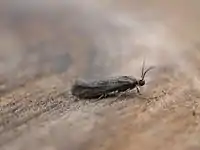Prays fraxinella
Prays fraxinella, the ash bud moth, is a moth of the family Plutellidae. It is found in Europe.

| Ash bud moth | |
|---|---|
 | |
 | |
| Scientific classification | |
| Kingdom: | Animalia |
| Phylum: | Arthropoda |
| Class: | Insecta |
| Order: | Lepidoptera |
| Family: | Plutellidae |
| Genus: | Prays |
| Species: | P. fraxinella |
| Binomial name | |
| Prays fraxinella Bjerkander, 1784 | |
| Synonyms | |
| |
The wingspan is 14–18 mm. The head is white or greyish ochreous.Forewings are white or greyish-ochreous ; some blackish dorsal strigulae ; a triangular blackish blotch, lighter or mixed with whitish on costa, extending along costa from near base to 2/3 ; some irregular blackish marks towards termen ; sometimes the whole wing is unicolorous dark fuscous. Hind wings are rather dark grey. The larva is greenish, marbled with red -brown above; dorsal line deep green; head pale brown, dark-spotted ;2 with two black spots.[1]
Adults are on wing from May to June and again in August in two generations depending on the location.

The larvae feed on Fraxinus excelsior and Fraxinus ornus. They mine the leaves of their host plant. The mine consists of an irregular small corridor with dispersed black frass. Often the corridor widens in the end into an irregular blotch with much less frass. The mine may begin at an egg shell, but the larvae can leave their mine and start a new one elsewhere in the leaf. In the latter case the corridor begins with a small round opening. Before the leaf is shed the larva leaves the mine and bores into the bark, where it hibernates. After hibernation they live as shoot borer or free among spun leaves.


Prays fraxinella has two colour forms, the typical white and black colouration and the melanic form f.rustica.
Recently, the form f.rustica, that has an orange head has been separated into an entirely new species, Prays ruficeps.
References
- Meyrick, E., 1895 A Handbook of British Lepidoptera MacMillan, London pdf
 This article incorporates text from this source, which is in the public domain. Keys and description
This article incorporates text from this source, which is in the public domain. Keys and description
- A. Maitland Emmet and John R. Langmaid eds., 2002 The Moths and Butterflies of Great Britain and Ireland Volume 3 (Yponomeutidae to Elachistidae) Curwen books
- Bjerkander, C. (1784) Insect-Calender, for år 1784. Kongl. Vetenskaps Academiens nya Handlingar 5: 319-329. Stockholm (Johan Georg Lange).
- Millard, P. (2013) Prays fraxinella (Bjerkander) (Lep.: Praydidae) is not monophagous on Ash. The Entomologist's Record and Journal of Variation 125 (5): 171.
- Stainton, H. T. (1870) The natural history of the Tineina 11: I-XIII, 1-330, pl. I-VIII. London (John van Voorst) – Paris (Deyrolle) – Berlin (E. S. Mittler und Sohn). as Prays curtisellus.